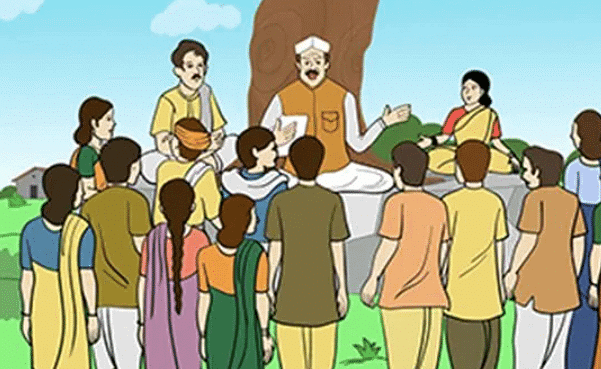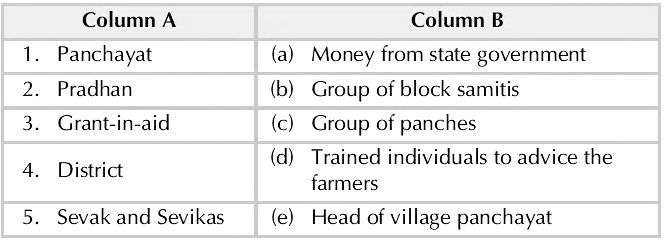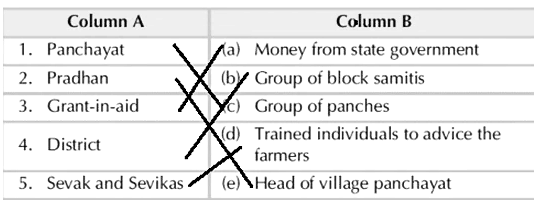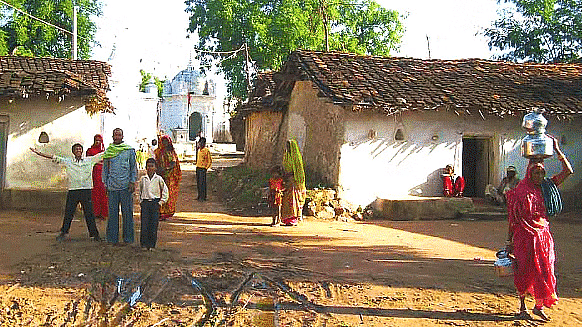Indian Villages - 1 Class 3 Worksheet SST

Q1: Multiple Choice Questions (MCQs)
(i) Which of the following are the parts of the rural government?
(a) Village panchayat
(b) Block samiti
(c) Zila parishad
(d) All of them
Ans: (d) All of them
The system has three levels: Gram Panchayat (village level), Mandal Parishad or Block Samiti of Panchayat Samiti (block level), and Zila Parishad (district level).
(ii) Who elects the members of a Gram Panchayat?
(a) Pradhan
(b) Villagers
(c) Individual
(d) Gram Sevika
Ans: (b) Villagers
The members of the Gram Sabha elect the ward members through a direct election.

(iii) How many women members should be a part of the village panchayat?
(a) Two
(b) One
(c) Three
(d) Five
Ans: (a) Two
While the 73rd and 74th Amendments to the Constitution mandate that at least one-third of the seats in the panchayats must be reserved for women.
(iv) Who elects the members of a village panchayat?
(a) State Government
(b) Village Panchayat members
(c) District Parishad
(d) Villagers
Ans: (d) Villagers
Members of a village panchayat are elected by the villagers.
(v) What is the primary source of income for the village panchayat to carry out welfare activities?
(a) Donations from villagers
(b) Funds from the Central Government
(c) Taxes and grants-in-aid
(d) Income from agricultural activities
Ans: (c) Taxes and grants-in-aid
Village panchayats receive money from taxes paid by villagers and grants-in-aid from the State Government to carry out their activities.
Q2: Fill in the blanks
(i) Disputes among villagers are settled by the ___________.
Ans: Disputes among villagers are settled by the Panchayat.
(ii) The members of a village panchayat are called ___________.
Ans: The members of a village panchayat are called Panch Every village.
(iii) ___________ is responsible for the education of adults in villages.
Ans: State Government is responsible for the education of adults in villages.
(iv) The head of the Gram Panchayat is known as __________ or __________.
Ans: The head of the Gram Panchayat is known as Pradhan or Sarpanch.
(v) Gram sevaks provide information about crops, seeds, and means of irrigation to __________.
Ans: Gram sevaks provide information about crops, seeds, and means of irrigation to Farmers.
Q3: Match the following
 Ans:
Ans:
Q4: True & False
(i) Blocks of villages are managed by block samiti.
Ans: False
Block Samiti is an intermediate link between the Gram Panchayat and the Zila Parishad. It works in coordination with the two institutions. It is known by different names in different states.
(ii) A village panchayat looks after the primary health centres of villages.
Ans: True
(iii) The panches are the head of the panchayat.
Ans: False
The Panchayat is chaired by the president of the village, known as a Sarpanch.
(iv) Gram Panchayat members are appointed by the State Government.
Ans: False
Gram Panchayat members are elected by the villagers, not appointed by the State Government.
(v) Civic amenities refer to facilities provided by private organizations in villages.
Ans: False
Civic amenities are facilities provided by the government for common people, not private organizations.

Q5: Answer the following questions
(i) What are the important functions of a village panchayat?
Ans: The civic functions relating to sanitation, cleaning of public roads, minor irrigation, public toilets and lavatories, primary health care, vaccination, the supply of drinking water, constructing public wells, rural electrification, social health and primary and adult education, etc.
(ii) What is a block samiti?
Ans: Block samiti is the second tier of the Panchayati Raj institution in India. Many gram panchayats form together to form block samiti by a block level. The panchayat samiti is the link between the gram panchayat (village council) and the zila parishad.
(iii) Describe the composition of a gram panchayat.
Ans: The Gram Panchayat is divided into wards and each ward is represented by a Ward Member or Commissioner, also referred to as a Panch of Panchayat Member, who is directly elected by the villagers. The Panchayat is chaired by the president of the village, known as a Sarpanch.
(iv) Who appoints the gram sevak and gram sevika?
Ans: Gram panchayat appoints the gram sevak and gram sevika.
Q6: Imagine you could introduce a new idea to make your village a better place to live. What would that idea be and how would it help everyone in the village?
Ans: If I could introduce a new idea to make my village a better place to live, I would set up a clean water supply system. This would ensure that all the villagers have access to clean and safe drinking water. It would help improve the health of everyone in the village, as clean water prevents diseases. It would also save time for people who currently have to walk long distances to fetch water. With clean water, our village would be healthier and more comfortable to live in!
FAQs on Indian Villages - 1 Class 3 Worksheet SST
| 1. What is the population of Indian villages? |  |
| 2. What are the main occupations of people in Indian villages? |  |
| 3. How is the infrastructure in Indian villages? |  |
| 4. What are the social challenges faced by Indian villages? |  |
| 5. What government initiatives are there to uplift Indian villages? |  |
















